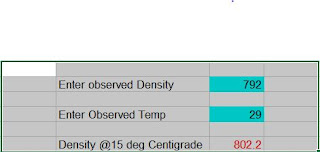- Excel Formula-Density Conversion to 15 deg C, table ASTM 53 B - 1980,

- Excel Formula-Density Conversion to 15 deg C, table ASTM 53 B - 1980, Excel sheet giving the Density 15 deg C figures from given observed Density and observed temperature for petroleum product as derived from ASTM tables 53 B. Density conversion to 15 deg C matches exactly with the ASTM conversion tables 1980. Lists of Android/iOs Apps developed on Petroleum Calculation - see here. (These apps convert Density/API gravity exactly as per ASTM tables 5a, 5b, 6a, 6b, 23a,23b, 24a,24b, 53a,53b, 54a,54b to standard temperature 15 C, 20 C and 60 F.) Example: Observed density is 792 kg/Cu. M and observed temperature is 29 deg C. Corresponding 15 deg C for this set of data comes 802.2 kg/Cu. M Excel Worksheet - green color cells observed density and observed sample temperature are variables and Red color digits are the answer - density at 15 deg C. Apps developed on Petroleum Calculations - see here. ...